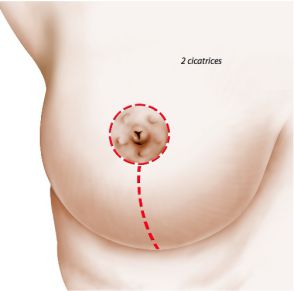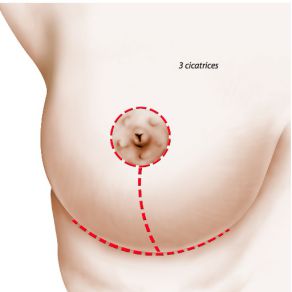Mammaplasty for hypertrophy can be performed from the end of growth and beyond, throughout the lifespan.
A subsequent pregnancy is obviously possible as well as breastfeeding, but it is advisable to wait at least six months after surgery.
The risk of developing cancer is not increased by this intervention. It was even slightly reduced.
BEFORE THE OPERATION
A usual preoperative assessment is conducted in accordance with regulations.
The anesthetist will be seen in consultation at least 48 hours before surgery.
Besides the usual pre-operative examinations, radiological assessment is prescribed breast (mammography, ultrasound).
Smoking cessation is strongly recommended at least one month before and one month after the intervention (smoking can cause a delayed healing).
Stopping any oral contraception may be required, particularly when associated risk factor (obesity, poor venous status, bleeding disorder).
No medication containing aspirin should be taken within 10 days before surgery.
TYPE OF ANESTHESIA AND CONDITIONS OF HOSPITAL
Type of anesthesia: This is a general anesthesia, in which you sleep completely.
Terms of admission: A hospital for one to three days is usually necessary.
INTERVENTION
Each surgeon adopts a technique of its own and it adapts to each case to obtain the best results. However, it may hold common basic principles:
The removed tissue is systematically sent to a specialized laboratory to be examined under a microscope (histology).
After surgery a modeling bandage with elastic bands shaped bra is crafted.
Depending on the surgeon and the importance of hypertrophy, the procedure can last from two to four hours.
AFTER THE INTERVENTION: THE OPERATING SUITES
The postoperative course is usually very painful, requiring only simple analgesics.
Swelling (edema) and bruising (bruises) breasts and a hindrance to the elevation of the arms are frequently observed.
The first dressing is removed after 48 hours and replaced with a lighter dressing, making a sort of elastic bustier made to measure.
The output occurs one to three days after surgery, and the patient is then reviewed in consultation postoperatively.
A bra provides good restraint is then put in place.
Wearing this bra is recommended for approximately one month, the waning of the intervention.
The son of suture, they are not absorbable, are removed from the eighth to the twentieth day after the operation.
Should be considered a recovery and a work stoppage for a period of 8-21 days.
It is advisable to wait one to two months to resume a sport.
THE RESULT
It can not be judged until one year after the intervention: chest then usually a harmonious, balanced and very close to the symmetry and natural curve. Beyond the local improvement, this procedure generally has a favorable impact on the balance of weight, practice sports, clothing options and psychological state.
 It is simply to have the patience to wait the time needed to mitigate scars and observe during this period proper supervision at the rate of a consultation about every three to six months for one year. Breast surgery is a breast that is natural and sensible, including hormonal and weight changes.
The goal of this surgery is to make an improvement and not to achieve perfection. If your wishes are realistic, the result should give you great satisfaction.
DISAPPOINTING RESULTS
It is basically scars, which are subject to careful monitoring: they frequently take a look pink and swollen during the second and third postoperative months beyond, they fade usually gradually, become less visible with time. However, they may remain enlarged, white or brown instead.
Regarding the scars, you should know that if they fade well, in general, over time, they do not disappear completely. In this regard, we must not forget that if the surgeon who performs the suture, the scar, it is the fact of the patient.
Sometimes it can persist for a breast asymmetry, whether the volume, height, size or orientation of the areola.
In all cases, a secondary surgical correction can be made, but you should wait at least a year or two.
POSSIBLE COMPLICATIONS
A reduction mammaplasty, although performed for aesthetic reasons in part, is nevertheless a real surgery, which involves the risks associated with any medical procedure, however small it may be.
We must distinguish the complications of anesthesia and those related to the surgery.
Regarding anesthesia, during the consultation, the anesthetist inform himself the patient anesthetic risks. You should know that anesthesia in the body sometimes unpredictable, and more or less easy to control: the fact of using a fully qualified anesthetist, working in a surgical context that the risks have become statistically very low.
You should know, indeed, that the techniques, anesthetic products and monitoring methods have made tremendous progress over the past thirty years, providing optimum safety, especially when the procedure is performed outside the emergency and in a healthy person.
Regarding surgery: choosing a qualified and competent plastic surgeon, trained in this type of surgery, you limit these risks, without removing them completely.
Fortunately, real complications are rare after a reduction mammaplasty performed in the rules. In practice, the vast majority of happens without any problems and patients are fully satisfied with their results.
However, and despite their low frequency, you must be informed of the possible complications:
• The thromboembolism (blood clots, pulmonary embolism), although generally very rare after this type of surgery are among the most dangerous. Rigorous preventive measures should minimize the impact:
port of anti-thrombosis stockings, early mobilization, possibly anti-coagulant therapy.
• The occurrence of infections requiring antibiotic treatment and sometimes surgical drainage.
• A hematoma may require an act of evacuation.
• Delayed healing can sometimes be observed, which
extends the operating suites.
• necrosis of the skin, gland, or areola is rarely seen with modern techniques, may be responsible for delayed healing (the risk is increased by tobacco intoxication, and if gigantomasties of hypertrophy or very important).
• Alterations in sensitivity, including nipple can be observed, but normal sensitivity usually returns within 6 to 18 months.
• Especially the evolution of scars may be unfavorable to the development of hypertrophic scars or keloids, occurrence and unpredictable changes that may jeopardize the aesthetic result of often lengthy and require specific local treatments.
Thus, in the vast majority of cases, this intervention, although previously studied and performed correctly, gives a very significant result in terms of comfort, even if the inevitable scarring remains the main drawback.
In total there should not overstate the risks, but simply aware that surgery, even seemingly simple, still a small share of hazards.
The use of a qualified Plastic Surgeon ensures that it has the training and skill required to avoid these complications, or effectively treat as appropriate.
    These are the pieces of information that we wanted to bring you in addition to the consultation. We recommend that you keep this document, read it again after the consultation and reflect "a clear head."
This reflection may raise new questions for which you wait for additional information. We are available to talk during the next consultation, or by phone, or even on the day of surgery when we meet in any way before anesthesia.


This fact sheet was developed under the aegis of the French Society of Plastic Reconstructive and Aesthetic Surgery (SOF.CPRE) as an addition to your initial consultation, to try to answer all the questions you can ask yourself if you plan to use a breast enlargement surgery.
The purpose of this document is to provide you with all the necessary and essential elements of information to help you make your decision with full knowledge of the facts. Also you is it advisable to read with the greatest attention.
DEFINITION
 Breast hypertrophy is defined by a volume of breasts too large, especially compared to the morphology of the patient. This excess volume is generally associated with sagging breasts (ptosis) and sometimes a certain degree of asymmetry.
Breast hypertrophy almost always involves a physical and functional impairment (pain in the neck, shoulders and back discomfort to the practice of sports, clothing difficulties). There is also often a significant psychological impact. These disorders warrant supported by health insurance under certain conditions.
OBJECTIVES
 The surgery aims to reduction in breast size, correction of ptosis and a possible asymmetry in order to get both breasts harmonious in themselves and in relation to the morphology of the patient ( both breasts reduced, ascended, symmetrical and remodeled).
PRINCIPLES
The procedure ablates the excess breast tissue. Volume is kept in harmony with the silhouette of the patient and according to his wishes. This residual breast volume is ascended, concentrated and remodeled.
It should then adapt the skin envelope, which requires removing the excess skin to ensure a good performance and a good curve for new breasts. The banks of the skin and cut are then sutured: these sutures are causing scars.
Often these scars in the shape of an inverted T with three components: periareolar the perimeter of the areola brown skin and white skin, vertically between the lower pole of the areola and the inframammary fold, horizontal, hidden in the crease under the breast.
The length of the horizontal scar is proportional to the magnitude of hypertrophy and ptosis.
Sometimes, especially when hypertrophy and ptosis is moderate, we can achieve a "vertical" method to remove the cross scar in the crease under the breast and reduce scarring its components periareolar and vertical.
MASTOPLASTY



AESTHETIC PLASTIC
& RECONSTRUCTIVE SURGERY

© Docteur Garson MAJ 2013